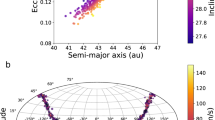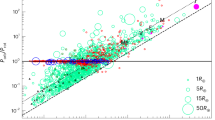Abstract
Pairs of asteroids sharing similar heliocentric orbits, but not bound together, were found recently1,2,3. Backward integrations of their orbits indicated that they separated gently with low relative velocities, but did not provide additional insight into their formation mechanism. A previously hypothesized rotational fission process4 may explain their formation—critical predictions are that the mass ratios are less than about 0.2 and, as the mass ratio approaches this upper limit, the spin period of the larger body becomes long. Here we report photometric observations of a sample of asteroid pairs, revealing that the primaries of pairs with mass ratios much less than 0.2 rotate rapidly, near their critical fission frequency. As the mass ratio approaches 0.2, the primary period grows long. This occurs as the total energy of the system approaches zero, requiring the asteroid pair to extract an increasing fraction of energy from the primary's spin in order to escape. We do not find asteroid pairs with mass ratios larger than 0.2. Rotationally fissioned systems beyond this limit have insufficient energy to disrupt. We conclude that asteroid pairs are formed by the rotational fission of a parent asteroid into a proto-binary system, which subsequently disrupts under its own internal system dynamics soon after formation.
This is a preview of subscription content, access via your institution
Access options
Subscribe to this journal
Receive 51 print issues and online access
$199.00 per year
only $3.90 per issue
Buy this article
- Purchase on Springer Link
- Instant access to full article PDF
Prices may be subject to local taxes which are calculated during checkout


Similar content being viewed by others
References
Vokrouhlický, D. & Nesvorný, D. Pairs of asteroids probably of a common origin. Astron. J. 136, 280–290 (2008)
Pravec, P. & Vokrouhlický, D. Significance analysis of asteroid pairs. Icarus 204, 580–588 (2009)
Vokrouhlický, D. & Nesvorný, D. The common roots of asteroids (6070) Rheinland and (54827) 2001 NQ8. Astron. J. 137, 111–117 (2009)
Scheeres, D. J. Rotational fission of contact binary asteroids. Icarus 189, 370–385 (2007)
Milani, A., Knežević, Z., Novaković, B. & Cellino, A. Dynamics of the Hungaria asteroids. Icarus 207, 769–794 (2010)
Pravec, P. & Harris, A. W. Binary asteroid population. 1. Angular momentum content. Icarus 190, 250–259 (2007)
Walsh, K. J., Richardson, D. C. & Michel, P. Rotational breakup as the origin of small binary asteroids. Nature 454, 188–191 (2008)
Scheeres, D. J. Stability of the planar full 2-body problem. Celest. Mech. Dyn. Astron. 104, 103–128 (2009)
Scheeres, D. J. Stability in the full two-body problem. Celest. Mech. Dyn. Astron. 83, 155–169 (2002)
Warner, B. D., Harris, A. W. & Pravec, P. The asteroid lightcurve database. Icarus 202, 134–146 (2009)
Scheeres, D. J. Minimum energy asteroid reconfigurations and catastrophic disruptions. Planet. Space Sci. 57, 154–164 (2009)
Bottke, W. F., Jr, Vokrouhlický, D., Rubincam, D. P. & Nesvorný, D. The Yarkovsky and Yorp effects: implications for asteroid dynamics. Annu. Rev. Earth Planet. Sci. 34, 157–191 (2006)
Warner, B. D. Asteroid lightcurve analysis at the Palmer Divide Observatory: 2008 May – September. Minor Planet Bull. 36, 7–13 (2009)
Galád, A., Kornoš, L. & Világi, J. An ensemble of lightcurves from Modra. Minor Planet Bull. 37, 9–15 (2009)
Acknowledgements
Research at Ondřejov was supported by the Grant Agency of the Czech Republic. D.V. was supported by the Czech Ministry of Education. D.P. was supported by an Ilan Ramon grant from the Israeli Ministry of Science, and is grateful for the guidance of N. Brosch and D. Prialnik. D.J.S. and S.A.J. acknowledge support by NASA's PG&G and OPR research programs. A.W.H. was supported by NASA and NSF. Work at Modra Observatory was supported by the Slovak Grant Agency for Science. The observations at Cerro Tololo were performed with the support of CTIO and J. Vasquez, using telescopes operated by the SMARTS Consortium. Work at Pic du Midi Observatory was supported by CNRS, Programme de Planétologie. Operations at Carbuncle Hill Observatory were supported by the Planetary Society’s Gene Shoemaker NEO Grant. Support for PROMPT has been provided by the NSF. F.M. and B.M. were supported by the NSF. We thank O. Bautista, T. Moulinier and P. Eclancher for assistance with observations with the T60 on Pic du Midi.
Author information
Authors and Affiliations
Contributions
This work was a team effort; here we specify only the most important contributions by individual authors. P.P. led the project and worked on most of its parts, except Supplementary Information sections 1 and 4. D.V. performed the backward orbit integrations and contributed to interpretations of the results. D.P. ran the observations and data reduction, and contributed to interpretations. D.J.S. developed the fission theory and worked out its implications for the observational data. A.W.H. contributed to interpretations and implications of the data. A.G., O.V., F.P., A.B., P.L., F.V., F.C., D.P.P., J.P., D.R., K.I., J.H., A.L., P.K., T.H., F.M., B.M., Yu.N.K., A.V.S. and A.L. carried out the observations, data reduction and analyses. S.A.J. ran simulations of the satellite ejection process in a proto-binary after fission.
Corresponding author
Ethics declarations
Competing interests
The authors declare no competing financial interests.
Supplementary information
Supplementary Information
This file contains Supplementary Figures 1- 45 with Legends, Supplementary Methods, Supplementary Data, Supplementary Discussions 1-2 with additional References and Supplementary Tables 1-2. (PDF 10292 kb)
PowerPoint slides
Rights and permissions
About this article
Cite this article
Pravec, P., Vokrouhlický, D., Polishook, D. et al. Formation of asteroid pairs by rotational fission. Nature 466, 1085–1088 (2010). https://doi.org/10.1038/nature09315
Received:
Accepted:
Issue Date:
DOI: https://doi.org/10.1038/nature09315
This article is cited by
-
Bounds on energy and angular momentum loss in the full n-body problem
Celestial Mechanics and Dynamical Astronomy (2023)
-
Asteroid families: properties, recent advances, and future opportunities
Celestial Mechanics and Dynamical Astronomy (2022)
-
Machine learning applied to asteroid dynamics
Celestial Mechanics and Dynamical Astronomy (2022)
-
Shapes, structures, and evolution of small bodies
Astrodynamics (2021)
-
Disassociation energies for the finite-density N-body problem
Celestial Mechanics and Dynamical Astronomy (2020)
Comments
By submitting a comment you agree to abide by our Terms and Community Guidelines. If you find something abusive or that does not comply with our terms or guidelines please flag it as inappropriate.



